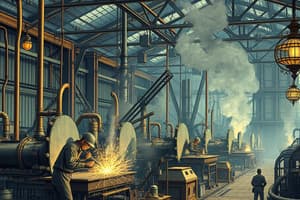Podcast
Questions and Answers
What happens to the thickness of metal as the bend radius becomes smaller?
What happens to the thickness of metal as the bend radius becomes smaller?
- The thickness doubles.
- The thickness increases significantly.
- The thickness decreases. (correct)
- The thickness remains unchanged.
What is the neutral axis in the context of bending operations?
What is the neutral axis in the context of bending operations?
- The layer of material that experiences no length change during bending. (correct)
- The center point where the maximum compression occurs.
- The axis at which the metal is most brittle.
- The outer side of the bend that stretches the most.
What is 'spring back' in bending processes?
What is 'spring back' in bending processes?
- An adjustment made to compensate for material imperfections.
- The return to original shape after bending forces are removed. (correct)
- An intentional deformity introduced in the bending process.
- The tendency for metal to deform permanently after bending.
What is meant by minimum bend radius in bending operations?
What is meant by minimum bend radius in bending operations?
What is a bend allowance in the context of a bent metal section?
What is a bend allowance in the context of a bent metal section?
What main improvement is achieved through grain refinement during the hot working process?
What main improvement is achieved through grain refinement during the hot working process?
Which of the following is a disadvantage of hot working?
Which of the following is a disadvantage of hot working?
Which of the following statements about cold working is correct?
Which of the following statements about cold working is correct?
What factor primarily dictates the amount of force required for deformation during cold working?
What factor primarily dictates the amount of force required for deformation during cold working?
What is a key characteristic of materials that cannot be hot worked?
What is a key characteristic of materials that cannot be hot worked?
Study Notes
Hot Working Processes
- Ingots often have small blow holes that are pressed together and eliminated to improve quality.
- Impurities in metal form inclusions that are broken and distributed evenly during processing.
- Coarse grains in metal are refined within recrystallization temperature range to achieve fine grain structure.
- Physical properties improved through grain refinement include increased ductility, impact resistance, strength, and homogeneity.
- Rolled steel exhibits greatest strength in the direction of metal flow.
- Energy required to shape steel in plastic state is significantly lower than in cold state.
Limitations of Hot Working
- High temperatures cause rapid oxidation and scaling, leading to poor surface finish.
- Close tolerances are challenging to achieve due to scaling impacts.
- Some metals are too brittle at high temperatures for hot working.
- Hot working equipment and its maintenance can be costly.
Cold Working Properties
- Conducted below recrystallization temperature, preventing appreciable recovery during deformation.
- Hardening effects persist, leading to decreased elongation and reduction in area of metal.
- Ultimate tensile strength, yield point, and hardness increase through cold working.
- Good surface finish achieved without crystallization; grains are elongated.
- Forms internal and residual stresses, increasing the likelihood of crack formation.
- Requires significant force for deformation due to the cold working process.
Bending Operations
- Bending transforms a straight length of metal into a curved form, essential for creating channels, tanks, etc.
- Bend radius (R) is the radius of curvature on the inner surface of the bend.
- Neutral Axis (NA) refers to the layer within the bend that remains unchanged in length during bending.
- Bend allowance (B) accounts for increased length of the metal after bending due to thickness reduction.
- The minimum bend radius indicates the threshold below which metal may crack during bending.
- Spring back is the tendency of metal to return to its original shape after bending, influencing design tolerances.
Shearing Processes
- Lancing uses punches and dies for partial cuts to create tabs, vents, and louvers, employing mechanical press techniques.
- Slitting involves cutting wide coils of metal into narrower strips using circular blades.
- Notching removes material from the edges of metal workpieces and typically employs shear blades for precision.
- Perforating creates multiple holes in a sheet, often arranged in patterns, using a punching process.
- Nibbling involves creating contours through overlapping punches along a workpiece edge.
- Shaving refines edges to ensure tight tolerances, removing minimal material.
- Slotting creates elongated holes or slots in metal.
- Trimming removes excess material from flanges or scrap from workpieces.
Forming Techniques
- Embossing produces shallow indentations or raised areas without altering metal thickness, achieved through a punch and die combination.
- Coining is a cold-forging operation that allows deformation mainly through compression for manufacturing items like coins and medals, requiring high pressure (1500 N/mm²) with heavy-duty hydraulic presses for effectiveness.
Studying That Suits You
Use AI to generate personalized quizzes and flashcards to suit your learning preferences.
Related Documents
Description
Test your knowledge on the fundamentals of manufacturing technology, including the treatment of ingots and refining processes. This quiz covers critical concepts such as inclusions, grain structure, and recrystallization in metal work.




